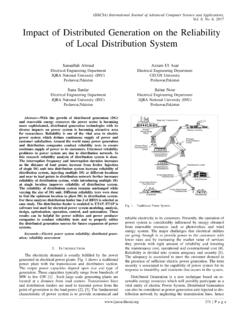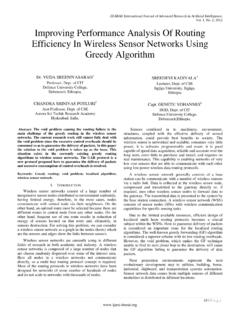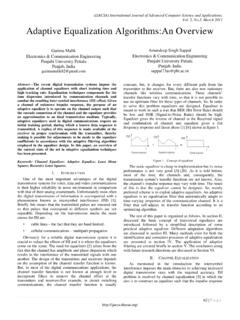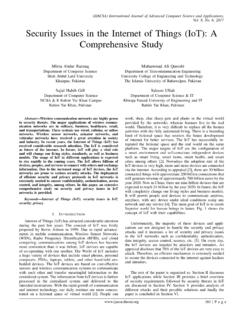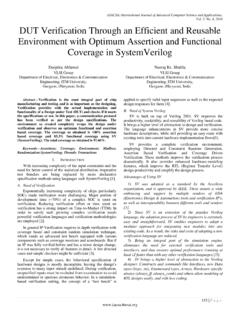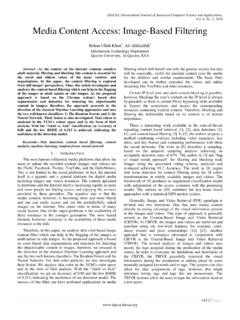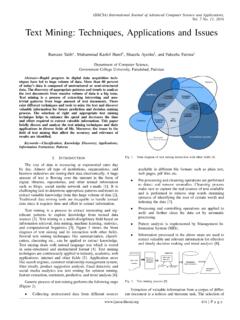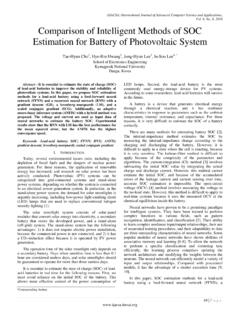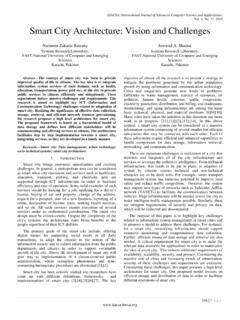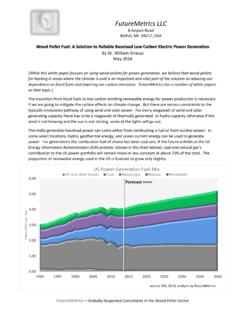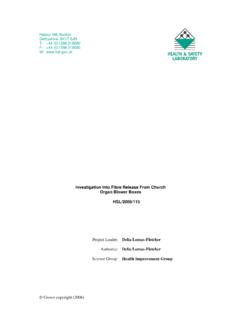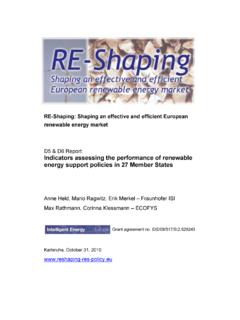Transcription of Multi-Criteria Wind Turbine Selection using …
1 (IJACSA) International Journal of Advanced Computer Science and Applications, Vol. 8, No. 6, 2017 128 | P a g e Multi-Criteria wind Turbine Selection using Weighted Sum ApproachShafiqur Rehman Center for Engineering Research King Fahd University of Petroleum & Minerals Dhahran, Saudi Arabia Salman A. Khan Computer Engineering Department University of Bahrain Sakhir, Bahrain Abstract wind energy is becoming a potential source for renewable and clean energy. An important factor that contributes to efficient generation of wind power is the use of appropriate wind Turbine . However, the task of selecting an appropriate, site-specific Turbine is a complex problem. The complexity is due to the presence of several conflicting decision criteria in the decision process.
2 Therefore, a decision is sought such that best tradeoff is achieved between the Selection criteria . With the inherent complexities encompassing the decision-making process, this study develops a Multi-Criteria decision model for Turbine Selection based on the concepts of weighted sum approach. Results indicate that the proposed methodology for finding the most suitable Turbine from a pool of 18 turbines is effective. Keywords wind Turbine ; renewable energy; weighted sum method; Multi-Criteria decision-making I. INTRODUCTION The exponential growth in population, materialistic life styles, and fast industrialization has resulted in higher demand for energy. However, the awareness and sensitivity of deteriorating environmental changes have prompted the use of renewable and cleaner sources of energy to safeguard the life of our very planet.
3 In recent years, substantial research has been devoted to develop systems and techniques that would enhance utilization of renewable energy sources. Such sources primarily include wind , solar, geothermal, and hydro, among others. Of these energy sources, wind power technology has emerged as a promising commercial alternative to the fossil fuel based energy [1]-[3]. The advantages of wind energy in comparison with traditional methods of power generation ( coal, gas, or nuclear plants, etc.) lie in fast deployment and commissioning of wind farms. This is attributed to wind turbines which require minimal operation and maintenance attention and cost. In addition, the operational age of turbines lasts between 20 and 25 years which are quite cost effective.
4 Furthermore, wind power harnessing is not restricted by geographical boundaries [4], [5], a case which is not prevalent with the fossil fuel based energy generation systems. A recent report by Global wind Energy Council [6] indicates that substantial progress has been made by several countries with regard to exploitation of wind energy. The statistics suggest that at the end of 2016, the global generation of wind energy reached 486,600 MW. This denotes an increase of around 2700% compared to that of year 2000. Just in a period of one year from 2015 to 2016, the cumulative wind power generation increased by from 432,680 MW in 2015 to 486,749 MW. China currently leads the global market with addition of 23,328 MW of wind power to its national grid in 2016.
5 Other prominent followers are USA, Germany, India, and Brazil adding 8,203, 5,443, 3,612 and 2,014 MW respectively in year 2016. Other countries such as France, Turkey, the Netherlands, UK and Canada are also catching up with the wind power generation. However, Africa and the Middle East are lagging behind, though some initiatives have recently been taken in some regions [6]. A fundamental challenge in harnessing wind energy is the maximization of energy output from turbines. It is a challenge since fluctuations arising in the speed of wind have a negative impact on energy generation [7]. The speed of wind depends heavily on geographical location, climatic conditions, topography, and height above ground level (AGL).
6 In a typical setup, speed of wind is measured between 8 to 12 meters AGL. The tower height at which the Turbine rotor is mounted is referred to as hub height. Since more wind is absorbed at higher hub heights, generally high hub heights are desired in a typical wind farm layout setting. However, the maximum hub height has a threshold due to installation, technical, maintenance, and economic issues. Another factor that affects the generation of energy is rotor diameter. While a bigger rotor diameter is associated with higher energy generation, rotor with smaller diameter is desired again due to cost and maintenance issues. In addition to hub height and rotor diameter, the factors of cut-in wind speed and rated wind speed also have impact on energy output of a Turbine .
7 Cut-in wind speed refers to minimum wind speed at which the Turbine starts functioning, while rated wind speed is referred to as the wind speed at which the Turbine produces its maximum rated energy. It is desirable to have low values of cut-in wind speed and rated wind speed so that the Turbine can operate in low windy sites. However, turbines with bigger rotor diameter are considered appropriate since they have large swept area, which in turn generates more power. In addition, turbines with higher rated capacity (the maximum power that can be generated by a Turbine ) require bigger rotor diameter. Thus, there is a need for a decision approach in order to find an optimal tradeoff between all the factors ( decision criteria ).
8 The rest of this paper is organized as: A review of relevant literature is given in Section 2. Novelty of the proposed work is discussed in Section 3. The research method (IJACSA) International Journal of Advanced Computer Science and Applications, Vol. 8, No. 6, 2017 129 | P a g e is presented in Section 4. The discussion as how goal programming is applied to the problem considered herein is given in Section 5. Section 6 provides the results and discussion. Finally, a conclusion is given in Section 7. II. LITERATURE REVIEW Significant attention has been given to wind Turbine Selection problem in during the past two decades. A qualitative approach was adopted by Sarja and Halonen [8] who interviewed domain experts.
9 Their research identified various Turbine Selection criteria such as product reliability and availability, production frequency of the vendor, cost, and maintenance patterns. Perkin et al. [9] utilized a genetic algorithm to find the most suitable Turbine while employing various Selection criteria such as rotor radius, generator size, hub height, and pitch angle. Nemes and Munteanu [10] proposed a system reliability based model to compare nine different Turbine types. A particle swarm optimization based algorithm was proposed by Chowdhury et al. [11] for Turbine Selection . They considered a single Turbine type while employing energy production capacity as the Selection criterion.
10 Firuzabad and Dobakhshari [12] used Turbine reliability as the decision criterion in a probabilistic model that they developed. The proposed approach was tested on five Turbine types. Bencherif et al. [13] developed a Weibull distribution based analytical approach and considered 24 different turbines models while using capacity factor as the decision criterion. Montoya et al. [14] proposed a Pareto- ranking based genetic algorithm to choose the best Turbine . Their decision model considered power output and deviation in daily power output as the Selection criteria . In an approach proposed by Chowdhury [15], more than 120 Turbine types were considered while using cost of energy as the Turbine Selection criterion.
